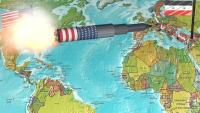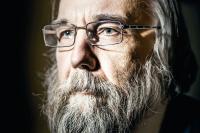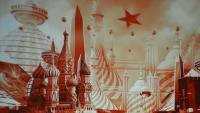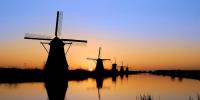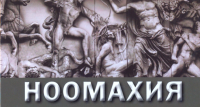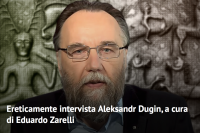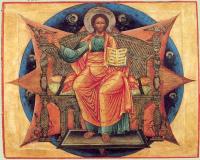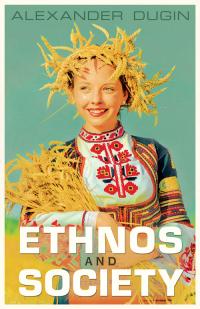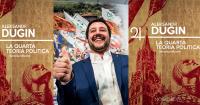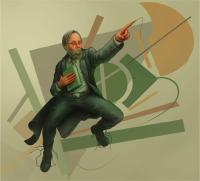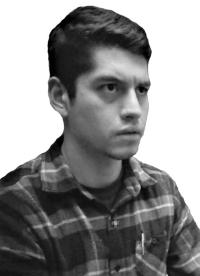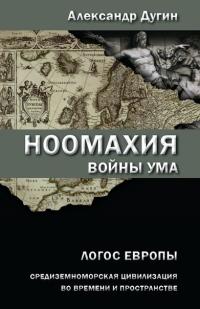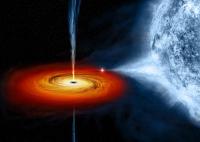Introduction to NOOMAHIA. Lecture 8. Noological analysis of Modernity
Introduction to NOOMAHIA. Lecture 7. Christian Logos.
Syria Under Fire: First Analysis
The US, UK, and France’s first missile airstrikes were rather improvisational and symbolic in nature.
Iranian, Russian, and Hezbollah forces were not attacked. Assad did not suffer strategically. The Syrian opposition, which expected much more, did not gain any serious advantages. Mass demonstrations in support of Assad are being held in Damascus.
Russian commentators have pointed out that France itself did not launch any missiles - all those launched were by British and American military forces.
Judging by the fact that all the missiles were launched at targets at a careful distance from the location of Russian soldiers, it seems that Mattis’ line won out in the US, as opposed to that of Bolton, who has insisted on directly attacking Iranians and Russians.
Introduction to NOOMAHIA. Lecture 6. European civilization
DECONSTRUCTING THE “CONTEMPORAL MOMENT”: NEW HORIZONS IN THE HISTORY OF PHILOSOPHY
Man, as the cosmic mediator, is situated on the border between both worlds, between Tradition (above) and modernity (below). He is always straddling this border, eternally, in both the era of Tradition’s predominance, and in the periods in which modernity temporarily wins. In his eidetic, eternal dimension, man himself is this border, and the movement of his spirit, his thought, his ways and methods of philosophizing, outline the content of that which lies on either side. Through his choice of orientation, spiritual or corporeal, man constitutes the time, the epoch, the age in which he lives.
Thus, residing in the “dark age”, the Kali-Yuga, is neither a fatality, a punishment, nor something arbitrary, but the Night’s testing of the grain of eternity, of the divine center that comprises the essence of man. In other words, no matter how far away the Golden Age might be, a kernel of it remains within man as hope, as opportunity, as a fulcrum, which can always be found in refusing to unconditionally and fatalistically (or unconsciously) accept the conditions of the Iron Age. Time is an illusion. The historial is no more than a sign, a metaphor that can be deciphered in different ways and appealed to freely. We ourselves choose the time in which we live. And if man is born in the modern world and in the West’s zone of influence, this means that he is included in the profound plans of eternity, and this reflects his mission and fate. Modernity is in Tradition, and Tradition is in modernity. But in different sections of the vertical world, their proportions adjust to being polar: in Heaven (Tradition) there is only a drop of hell (the Biblical serpent that first appeared in paradise), and in hell there is a drop of Heaven. But this is enough to stretch a semantic thread of sacred history, or hiérohistoire (in Henry Corbin’s formulation) between these drops.
The Pole of the Russian Circle: Moscow’s Place in the Sacred Geography of Russia
Questions of geography are very tightly linked to psychological archetypes. Every people, every civilization, every culture sees and understands space in its own unique way. There always exists a kind of code that serves as a distinctive trait of the national territorial myth.
Reconstructions made by modern historians of religions, sociologists, and anthropologists allow us to speak of an entire science (sacred geography) that predetermined our ancestors’ perception of the surrounding world in its spatial dimension. The norms of this sacred geography formed the foundations of epics, biographies, legends, traditions, myths, and fairy tales.
As the rational aspects of life developed, this sacred geography became part of the unconscious, thus determining deep psychic archetypes, rudimentary reactions, and the typology of slips and dreams. Having disappeared from the ancient stage, the geography of the myth passed into the sphere of subconscious reactions; however, this does not mean that it lost its hypnotic power.
There are peoples who visualize their homeland, their country, as an island. Others see it as a plain hemmed in by mountains. Still others see it as a space between two or more great rivers, or as an uninterrupted mountain range, or as a coastline, and so on and so forth. It is on the basis of this sacred geography of the homeland that an idea of the entire cosmos is formed.
Moscow as an Idea
Moscow is not just a great city, not just a great capital, not just the symbol of a gigantic Empire. Moscow is a basic concept of theology and geopolitics.
Moscow has been called the “Third Rome” not merely as a metaphor or self-indulgent manifestation of purely national pride. Everything goes much, much deeper. Orthodoxy knows the special teaching of the “three Romes.” The first was imperial Rome before Christ, the same state on whose territory the Son of God set foot on earth. This Rome was a universal reality that united enormous spaces and manifold peoples and cultures in civilizational unity.
The Second Rome, the New Rome, was Constantinople, the capital of the Roman Empire, which had accepted the blessing of holy christening. From that point forward, the Roman Empire acquired a strictly ecclesiastical, deeply Christian meaning. The Orthodox Emperor (Basileus), as head of the Empire, was identified with the mysterious person from the Apostle Paul’s Second Epistle to the Thessalonians: the “withholder”, “katechon”, who in the end times is fated to prevent the “coming of the son of perdition.”
The coming of Christ is a central event in world history. Everything that preceded it was a presage. What followed it was the universalization of the Gospel. And, in the Orthodox conception of the world, the center of history in the Christian era was Rome, the New Rome, Constantinople and its ruler, the Orthodox Basileus.
Existential Dutch: stolen identity (letter of Dutch philosopher)
Heidegger himself later called Sein und Zeit the most old-fashioned book ever written. We believe that in the way our economically driven political speech develops, we experience that in Dutch ‘ de wal het schip keert’ , meaning literally that the shore is the only thing that can stop the ship. We are caught up in a form of management. The thought of an Eurasian continent as a mediator between the Atlantic and the Asian might for a Dutch metaphysician be felt as the relieve of a burden. Heidegger saw his own mission in preparing European thinking for a confrontation with the East.
Bringing the geopolitical question back in the philosophical and political agendas means also the necessity of posing the question of the relation between the two. After all the question of politics is again the Schmittian question of friend or foe. When we would be so bold to identify the foe with the antichrist, Heideggers remark in the black notebooks spring to mind: ‘In relation to liberalism the antichrist is a small boy’ .
To work on a new political theory is a matter of great importance, but also a thing that requires great care. Perhaps this care, Sorge, for Heidegger in Sein und Zeit the unity of Dasein, is the driving force itself.
Introduction to NOOMAHIA. Lecture 5. Logos of Dionysus.
Introduction: The Aims and Tasks of Noomakhia
The title of Noomakhia, which literally means “war of the mind” (Noomachy) [4] – and which can also be conceived of as “war within the mind”, “war of minds”, or even “war against the mind” – is intended to emphasize the conflictual nature of logoi structures as well as the multiplicity of noetic fields in each of which surprises, conflicts, aporias, struggles, contradictions, and opposition lie in wait for us. The field of thinking is the field of warfare [5]: thoughts wage ceaseless wars not only against phenomenality, matter, and their own reorganization into elements (whether existing or not is an open question), natural law, dispersion, non-structurality escaping the “control” of multiplicity, etc., but also against other types of thoughts, other thoughts, and the complex diversity of vertical and horizontal, noetic and noeric chains which permeate the reality of the world on different planes and different geometries. Wars between people, including even the most cruel and bloody, are but pale comparisons to the wars of the gods, titans, giants, elements, demons, and angels. And these, in turn, are but figures illustrating even more formidable and profound wars unfolding in the Mind, in the sphere of the Nous and its limits in which the Mind itself borders the zone of Madness. Thus, everything is Noomachy, even that which is bigger and came first of all – ϋπερπαντα. War, according to Heraclitus, is the father of all (πολεμος πατηρ παντων). Indeed, it is about this, the “father of all”, that Noomakhia is written.
Priests and Warriors should regain its essential position
To overcome the Modernity is not easy. Any alternative will be impregnated by the some modern prejudices. We need be afraid of nothing – including regress, authoritarianism and so on. We are ashamed of all such phenomena because we are still Modern. I like communitarianism. It has in itself something premodern as organic community of people living in the personalized relations to the nature and each other. But we shouldn’t exclude the imagination of Empires, hierarchies and most of all sacredness, We need to restore all three traditional types – Priest, Warrior and Peasant. The economy is the field of peasant. So the peasant community and small manufacturers are the base of the material aspect of society. But outside of Modernity the materiality is the last concern. So the real basis of the society should be the Heaven – spiritual life, sacred values. The Earth should be once more conquered by the Heaven. So the Priests and Warriors should regain its essential position. So we need reverse the Modernity that began with quite opposite with the putting the material over spiritual, the Earth over the Heaven.
We are the Church of the End Times
The Romanov period saw a continuous process of Russian Orthodoxy’s silent return to pre-Petrine times; this was not a conservative-revolutionary path (as with the Old Believers), but a conservative-evolutionary one whose existence was due mainly to the archaic nature of the provincial clerics and the multitude of simple parishioners. In a certain sense, the enthronement of the antichrist in the Church did not fully succeed, despite the fact that during the individual intervals of Peter the Great’s rule the impression formed that this was taking place. Still, because of some higher reasons, the final chord was delayed, even though the forces of the antichrist multiplied tenfold.
Although it was at the price of compromise and adaptability, Russian Orthodoxy maintained its unity, the legality of its hierarchy, eucharistic succession, and loyalty to the fundamental norms of patristic tradition. The Saint-Petersburg stage was characterised by a certain split in the official Church. At the lower levels it moved towards the Old Faith, i.e. towards Orthodoxy in its purest form. At the top, it was oriented towards Western adjustments and norms, as official theology repeated the model of Catholic-Protestant teachings, and the general spirit was fully apostate. Nikon’s reforms significantly damaged both rites and liturgical books. The synod became an administrative agency in a bureaucratic, profane government.
Introduction to NOOMAHIA. Lecture 4. Logos of Cybele.
Introduction to NOOMAHIA. Lecture 3. Logos of Indo-european civilization
Ethnos and Society
In this monograph, Dugin provides an overview of the primary foreign and Russian sources and schools that influenced the establishment of ethnosociology as an independent and original scientific discipline. Dugin offers a profoundly philosophical approach to the categories of the “ethnos,” “narod,” “nation” and “society,” providing clear definitions of these concepts, and expounding a broader ethnosociological taxonomy. For the first time in the field, this work brings a consistent approach to a broad spectrum of knowledge, as well as elucidating various methodologies of ethnosociological analysis, bringing everything together into a single, easily applicable system.
This volume is an invaluable manual for those specializing in sociology, philosophy, political science, cultural studies, ethnology, international relations, state, and law, as well as being of interest to those who follow the current developments in the humanities.
This volume is an invaluable manual for those specializing in sociology, philosophy, political science, cultural studies, ethnology, international relations, state, and law, as well as being of interest to those who follow the current developments in the humanities.
Introduction to NOOMAHIA. Lecture 2. Geosophy
The Fourth Political Theory and the Italian Logos
The Fourth Political Theory treats the concept “narod” as an independent legal and philosophical category, beyond its interpretations in the context of the three political theories of Modernity. But the “narod” is understood existentially, as Dasein. Heidegger’s formula “Dasein existiert völkisch” is key. The Fourth Political Theory understands the narod, the populus, as Dasein, Volk als Dasein. That makes the phenomenon of populism not indistinct, chaotic, and spontaneous, but deeply grounded, philosophical, and avant-garde. In this case, the Fourth Political Theory can be regarded as a “metaphysics of populism,” explaining its appearance and supplying the blind protest of humanity against the satanic elite that has seized power over it with a strategy, consciousness, thought, a system, and a plan of struggle.
To conclude this preface to the Italian edition, I want to emphasize: the Fourth Political Theory appeals to everyone – to traditionalists, socialists, liberals, conservatives, persons with convictions and persons without convictions. It is an invitation to think, and not the imposition of ready-made judgments or models. Our goal is to awaken in Italian society an interest towards political philosophy, towards ideas and towards an acute – truly Italian – perception of reality.
The Fourth Political Theory and the Italian Logos
I admire Italy, or more precisely the many societies, cultures, peoples, and states comprising the history of Italy from the Etruscans and Roman Empire to the Vatican and Risorgimento. I dedicated a separate book to the “Latin Logos,” where I expressed my love for the Italian spirit and for the beauty of dramatic and elevated Italian thought.
Introduction to NOOMAHIA. Lecture 1. The introduction
CRISOLISM AND THE RELEVANCE OF DUGIN´S FOURTH POLITICAL THEORY FOR PERU AND LATIN AMERICA
Peruvian social scientists are reducing their work to the strict academic terrain, this relationated with the fear of social rejection and labor ostracism, which would imply their participation in political projects and social reforms, this situation is generating that, today, political parties are in a lack of doctrine, strategies and coherent programs. The decline of the Peruvian political parties, we endorse, is also determinate by the flight of thinkers and social scientists from them.
Due to this situations, and in order to amend them, investigations are being carried out in Peru, in such areas as political philosophy, metapolitics and geopolitics. For the sake of identifying the real obstacles that interfere with our progress as a nation, and to give with this the necessary tools for the institutionalization of a political project. It is the return of social scientists to the political arena, since today, far from the humanities, the Peruvian political parties are only political companies, prey to corruption, improvisation and clientelism.
The Logos of Europe: Catastrophe and the Horizons of Another Beginning
Modern European civilization is the historical continuation of Mediterranean civilization. The Indo-European element is predominant in this continuity, as the Indo-European tradition makes up Europe’s main linguistic and cultural matrix. If we recall Dumézil’s reconstruction of the trifunctional system here, then we immediately obtain a sociological map of Europe, the social structure of which is dominated by a constantly reproduced principle of three prevailing castes: priests, warriors, and producers. Indeed, we encounter none other than this stratification of European societies at the most different historical stages and under different names and titles.
The classic expression of this order was the ancient epoch of Mediterranean societies beginning with the Achaean conquests and Homeric Greece. Such a system was characteristic of Ancient Greece and Rome with the exception of periods of decline distinguished by a strengthening of the political positions of “urban dwellers”, who represented a mixture of higher castes with uprooted peasants that gave birth to a new type of merchant hitherto alien to classical Indo-European societies. This type of merchant could have taken shape through the degradation and materialization of the warrior caste (which Plato describes in his Republic as the phenomenon of timocracy), or from below through a specific deviation from social type on the part of former peasants or urban artisans. It cannot be ruled out that this was the result of influences that were altogether foreign to the Indo-European cultural circle, such as Phoenician or, more broadly, Semitic cultures, for whom trade was a widespread social occupation. In the city-states of Greece, “urban dwellers” and “citizens”, i.e., “townspeople”, formed a specific social milieu in which the three classical functions of Indo-European society found parodical manifestation. In the very least, this is what Aristotle presented in his Politics. The authority of king-priests (the sacred monarchy) transformed into tyranny. The domination of the warrior aristocracy gave way to domination by a financial oligarchy. The organic self-government of ethnically homogeneous and solidary communities (polity) became “democracy”, or the power of the sporadic and disparate crowd unified only by territory of urban residence.
CHRISTIANITY AND SCIENCE
If one takes the third position on religion and modern science, life will become difficult (perhaps even unbearable). In this case, we must not only distrust the ideology of the modern (definitely non-Christian, often directly anti-Christian) society, but also the world itself, which, if we think about it, is pushed onto so heavily onto us by the entire structure of upbringing, education, study, and culture that we are convinced that it is reality, nature, existence, truth. Once can debate an ideology (although this is difficult, if it is a totalitarian one like all Modern ideologies: communism, fascism, and the most totalitarian one of all, liberalism!), but to distrust one’s own sensory organs, to see that which ‘isn’t’ behind ‘natural’ phenomena (as was said to us by our parents and teachers), i.e. the cosmological power of angels and demons is a direct road to insanity.
I do not know the answer to this question, as it can neither be easy nor understood. I can only express certain assumptions without being confident in neither their effectivity nor their ability to change anything.
First, we must give ourselves the task of fundamentally researching the philosophy of Plato and Aristotle. This demands effort, but it is the foundation of Christian thought. Without Plato, the fundamental theological theses of the Cappadocian school, or even the most fundamental teachings about the Trinity, creation, etc., to say nothing of the Aeropagites, asceticism, or hesychasm would have no foundation at all. The fundamentals of Christian theology were developed by the Platonists. And it is Platonic cosmology (with Christian corrections) that was patched into this philosophy. In the Christian context, this corpus is most clearly represented by the Aeropagites, in the West by Scotus Eriugena.
IN DEPTH: Nationalism in the Third World and the Idea of a Fourth Political Theory
e are talking about ideologies such as Chavismo in Venezuela, undoubtedly patriotic socialist doctrine, based on the political creativity of Hugo Chavez, who managed to forge a Fourth Way in relation to liberal-capitalism, communism and chauvinistic nationalism, reconciling its Peronist and Velasquist influences with perspective of a Communal State based on the productive autonomy of the workers. Your purpose? As outlined in his Plan de la Patria, establishing a multipolar and pluricentric world order and effectively building a socialism based on patriotic values in Venezuela.

